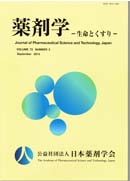Volume 69, Issue 4
Displaying 1-15 of 15 articles from this issue
- |<
- <
- 1
- >
- >|
Foreword
-
Japanese Pharmacist Education Prompted by Coa-Curriculum Is Just Similar to the Party on the Titanic2009 Volume 69 Issue 4 Pages 243
Published: 2009
Released on J-STAGE: March 31, 2019
Download PDF (156K)
Fora
-
2009 Volume 69 Issue 4 Pages 244-246
Published: 2009
Released on J-STAGE: March 31, 2019
Download PDF (306K) -
2009 Volume 69 Issue 4 Pages 247-250
Published: 2009
Released on J-STAGE: March 31, 2019
Download PDF (392K)
Relay Plazas
-
2009 Volume 69 Issue 4 Pages 251-252
Published: 2009
Released on J-STAGE: March 31, 2019
Download PDF (242K) -
2009 Volume 69 Issue 4 Pages 253-255
Published: 2009
Released on J-STAGE: March 31, 2019
Download PDF (296K)
R&D
-
2009 Volume 69 Issue 4 Pages 256-261
Published: 2009
Released on J-STAGE: March 31, 2019
Download PDF (633K)
Researeh Laboratory
-
2009 Volume 69 Issue 4 Pages 262-266
Published: 2009
Released on J-STAGE: March 31, 2019
Download PDF (828K)
Young Researeher
-
2009 Volume 69 Issue 4 Pages 267-271
Published: 2009
Released on J-STAGE: March 31, 2019
Download PDF (534K)
Current Topics
-
2009 Volume 69 Issue 4 Pages 272-276
Published: 2009
Released on J-STAGE: March 31, 2019
Download PDF (979K) -
2009 Volume 69 Issue 4 Pages 277-281
Published: 2009
Released on J-STAGE: March 31, 2019
Download PDF (1278K)
Introduction
-
2009 Volume 69 Issue 4 Pages 282-288
Published: 2009
Released on J-STAGE: March 31, 2019
Download PDF (1192K)
Regular Articles
-
2009 Volume 69 Issue 4 Pages 289-296
Published: 2009
Released on J-STAGE: March 31, 2019
Download PDF (790K) -
2009 Volume 69 Issue 4 Pages 297-306
Published: 2009
Released on J-STAGE: March 31, 2019
Download PDF (1576K)
News
-
2009 Volume 69 Issue 4 Pages 307-308
Published: 2009
Released on J-STAGE: March 31, 2019
Download PDF (197K)
News
-
2009 Volume 69 Issue 4 Pages 309-311
Published: 2009
Released on J-STAGE: March 31, 2019
Download PDF (572K)
- |<
- <
- 1
- >
- >|
